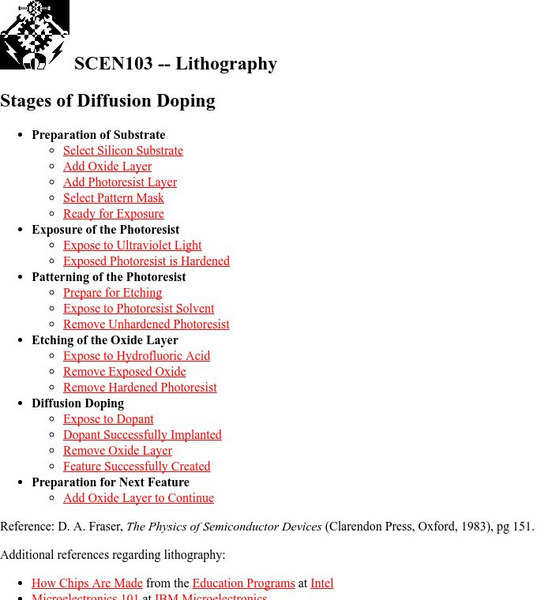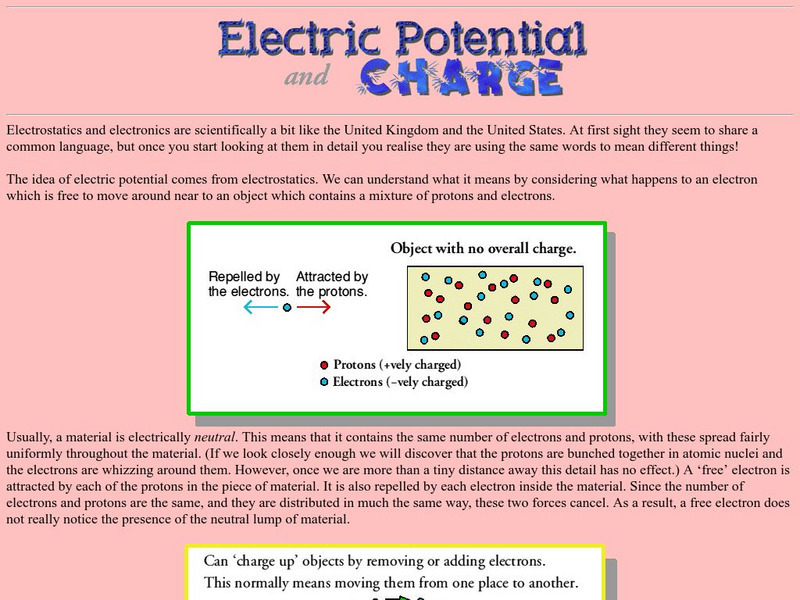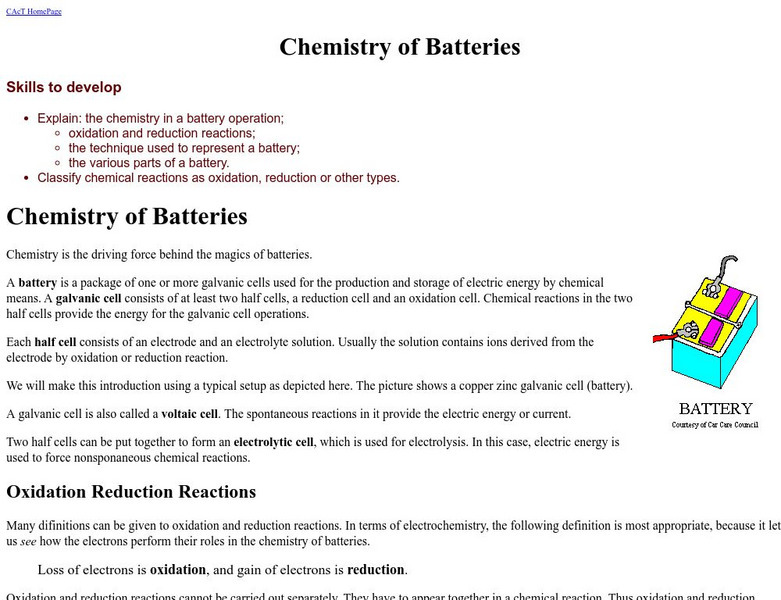Science Education Resource Center at Carleton College
Serc: Properties of Electrostatic Charge: Interactive Lecture Demonstration
Learners will investigate the properties of charge, charge by contact, the polarization of charge, and charge by induction. Through the use of demonstrations, students should have a thorough understanding of the movements of electrons...
Simon Fraser University
Chem1 Virtual Textbook: The Quantum Atom
Acting as a subtopic of the General Chemistry Virtual Textbook's section on Atoms and the Periodic Table, this site specifically addresses the quantum atom and related topics. The related topics include the wave function and its physical...
Simon Fraser University
Chem1 Virtual Textbook: The Quantum Numbers
Acting as a subtopic of the General Chemistry Virtual Textbook's section on Atoms and the Periodic Table, this site discusses quantum numbers of electrons in atoms including topics such as principal quantum number and orbitals of the...
Simon Fraser University
Chem1 Virtual Textbook: Electron Electron Repulsion
Acting as a subtopic of the General Chemistry Virtual Textbook's section on Atoms and the Periodic Table, this site discusses repulsion of electron pairs. Diagrams and charts of the repulsion are also provided.
Other
University of Winnipeg: The Pauli Exclusion Principle
This site provides information concerning the idea behind the Pauli Exclusion Principle. Includes basic terminology and explanations for understanding.
Museum of Science
The Atoms Family: Spectroscope of an Atom
"The Phantom has provided you with a simulated spectroscopy of an Atom! Amuse the Phantom by observing the spectroscope and you'll learn more about the Atom." Observe and review the structure of the atom.
Wikimedia
Wikipedia: Photoelectric Effect
Wikipedia provides excellent information on the photoelectric effect, including it's history, explanations, common uses, and more.
Crescent Public Schools
The Internet Science Room: Quantum Numbers
Using diagrams, illustrated examples, and student practice this chemistry class tutorial explains quantum numbers.
Michael Blaber, PhD
Fsu: Basic Concepts of Chemical Bonding: Exceptions to the Octet Rule
Lists the exceptions to the octet rule and provides a discussion and diagrams explaining each one. Includes clear diagrams illustrating this concept.
Dartmouth College
Dartmouth College: Chem Lab: Welcome to General Chemistry Laboratory!
Geared towards helping Dartmouth College students starting General Chemistry Laboratory, this site offers resources important for anyone in the lab. Learn why you should keep a lab notebook and how to keep yourself and others safe. This...
Open Curriculum
Open Curriculum: Electron Configurations
This Kahn Academy video will help students understand why electrons align in atoms the way they do.
Thomas Jefferson National Accelerator Facility
Jefferson Lab: It's Elemental: Element Math Game
The interactive activity examines the Periodic Table of Elements. Learners answer questions about the number of protons, electrons, neutrons, or nucleons that an atom of an element contains.
Wikimedia
Wikipedia: Louis Victor De Broglie
A brief biography of Louis-Victor de Broglie, including a concise review of his studies.
Wikimedia
Wikipedia: Max Planck
Discover the life and accomplishments of the great German scientist Max Planck. This site also provides links to sites explaining theories and scientific terms that are associated with Planck.
Concord Consortium
Concord Consortium: Molecular Workbench: Electrons in Atoms and Molecules
A model that explores why electrons are so important in chemistry. Investigate electron clouds, what happens when two atoms come together, and chemical polarity.
Lawrence Berkeley National Laboratory
Berkeley Lab: Particle Adventure: The Standard Model
An introduction to the Standard Model, a theory which attempts to explain atomic structure using leptons, quarks, and force carrier particles.
Other
University of Delaware Physics Department: Lithography
University of Delaware Physics Department provides this indexing page for a slide show presentation.
Other
Univ. Of Delaware Physics: More Semiconductor Physics
The University of Delaware Physics Department provides this site from a site titled "Silicon, Circuits, and the Digital Revolution," here is a series of four pages which explain the details behind how semiconductors work. An introduction...
Other
Erik's Chemistry Page: Electronic Structure of Atoms
A description of quantum theory, the Bohr model of the atom, the quantum mechanical atom, the Scrodinger equation, and quantum numbers.
Other
Kidstorm: Lightning
Learn about lightning formation and lightning safety with this detailed webpage.
State University of New York
State University of New York: Electron Configuration of Ions
The following simulation displays electron configurations for elements in relation in relation to the element's position on the periodic table.
University of St. Andrews (UK)
University of St. Andrews: Physics and Astronomy: Electric Potential and Charge
From The Scots Guide to Electronics web site. The meaning of electric potential is described. A combination of diagrams and words are used to explain this difficult concept without the use of mathematics. Very well done!
University of Waterloo (Canada)
Computer Assisted Chem. Tutorial/chemistry of Batteries
A superb explanation of how a battery works. Discusses the associated chemistry which explains how a battery produces a voltage. Includes a series of "Confidence Building Questions."
Quia
Quia: Chemical Bonds (Ionic and Covalent) Quiz
This is 21-question multiple choice quiz over chemical bonds was written for a 7th-grade science class.





















